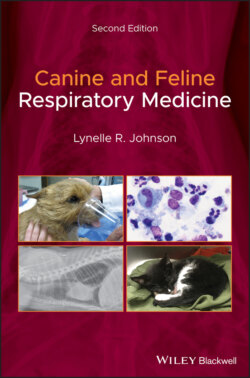Читать книгу Canine and Feline Respiratory Medicine - Lynelle Johnson R., Lynelle R. Johnson - Страница 13
Nasal Discharge History
ОглавлениеNasal discharge is almost always a sign of local disease within the nasal cavity. One exception is eosinophilic bronchopneumopathy, an inflammatory condition of the epithelium lining the airways and the lung that can also involve the nasal epithelium. Interestingly, cats with eosinophilic lower airway disease do not display this clinical finding. Nasal discharge can also accompany infectious lower respiratory tract disease in the dog (or occasionally the cat) that coughs airway material into the nasopharynx, which subsequently drains from the nose. Finally, some animals with vomiting or regurgitation will display nasal discharge because of nasopharyngeal regurgitation. This might be more common in brachycephalic breeds, which frequently develop pharyngeal collapse due to increased respiratory effort (Pollard et al. 2018). Brachycephalic animals also are prone to mishandling of food orally due to excessive pharyngeal folds and because of multiple gastrointestinal diseases, including hiatal hernia, gastroesophageal reflux, and mild inflammatory intestinal disease that leads to vomiting or regurgitation. All of these features contribute to nasal discharge in these animals.
The most common respiratory causes of nasal discharge include infectious, inflammatory, and neoplastic disorders as well as dental‐related nasal disease and foreign bodies (Table 1.1). Additional clinical signs that can be seen in animals with nasal disease include sneezing or reverse sneezing, pawing or rubbing at the face, noisy breathing or mouth breathing, facial pain, or an unexplained odor near the head.
When evaluating the animal with nasal discharge, important considerations include the duration of signs, the type of discharge as well as changes in its character over time, and the presence of unilateral, bilateral, or progressive signs. Acute nasal discharge is often accompanied by sneezing and is most commonly associated with infectious upper respiratory tract disease or a foreign body. Affected animals can have signs that resolve within a week without treatment or they can be so severely affected that animals are rapidly evaluated by a veterinarian to determine a plan for intervention. Occasionally, dogs with nasal foreign bodies will have resolution of signs despite the continued presence of organic matter within the nose. This represents a diagnostic and therapeutic dilemma in the dog that has an appropriate signalment and exposure history for a nasal foreign body, because failure to investigate signs and potentially retrieve a foreign body can have long‐term consequences. The most frustrating cases are those with chronic, slowly progressive nasal discharge and sneezing over weeks to months to years before the severity of disease prompts veterinary care. Prioritizing empiric therapy requires an assessment of the top differential diagnoses and determining what treatment is least likely to worsen signs, to interfere with further diagnostic testing, or to hamper the owner from pursuing specific work‐up.
Table 1.1 Causes of nasal discharge in dogs and cats.
| Dog | Cat | |
| Infectious | Canine infectious respiratory disease complexa Aspergillus Cryptocococcus Penicillium Rhinosporidium | Acute upper respiratory tract disease complexb Cryptococcus Aspergillus |
| Inflammatory | Lymphoplasmacytic rhinitis | Feline chronic rhinosinusitis |
| Neoplastic | Adenocarcinoma Sarcoma Lymphoma | Lymphoma Adenocarcinoma Sarcoma |
| Local | Tooth root abscess Oronasal fistula Trauma Foreign body Nasal or nasopharyngeal polyp | Nasal or nasopharyngeal polyp Tooth root abscess Oronasal fistula Foreign body Trauma |
| Other | Primary ciliary dyskinesia Nasal mites Xeromycteria (dry nose syndrome) | Primary ciliary dyskinesia |
a Reported causes include canine adenovirus‐2, canine parainfluenza‐3 virus, canine respiratory coronavirus, canine herpesvirus, canine distemper virus, Bordetella, Mycoplasma, and Streptococcus equi subsp. zooepidemicus. Canine influenza viruses and pneumovirus are new additions to the list of etiologic agents and novel viral organisms are continually being identified.
b Reported causes include feline herpesvirus‐1, feline calicivirus, Chlamydia, Bordetella, and Mycoplasma.
With many causes of nasal signs including viral disease or foreign body, discharge is serous initially and then progresses to a mucoid character when inflammation induces mucus production or when secondary bacterial infection develops. Yellow‐green nasal discharge can be an indicator of eosinophilic disease, but is also encountered in other infectious or inflammatory conditions, while brown‐tinged discharge suggests the presence of blood within the mucus. Bright red blood can be found in combination with nasal discharge because of trauma to blood vessels associated with the primary disease process or due to the severity of sneezing. Epistaxis with or without nasal discharge has been associated with local causes of disease, including inflammatory rhinitis, canine aspergillosis, and neoplasia; however, in animals with pure epistaxis, systemic vascular disorders must be considered, including coagulopathies and systemic hypertension.
Nasal discharge that is strictly unilateral is most suspicious for local disease due to a foreign body, trauma, tooth root abscess or oronasal fistula, or an early fungal infection or neoplasm. However, systemic vascular disease or a coagulopathy can also result in unilateral nasal bleeding. Also, inflammatory diseases such as lymphoplasmacytic rhinitis in the dog and feline chronic rhinosinusitis can present with lateralizing clinical signs, although in most cases imaging and histology reveal that both sides of the nasal cavity are affected.
Non‐respiratory history that should be collected includes environmental exposure to foreign bodies, previous trauma, and evidence of vomiting or regurgitation. For animals with epistaxis, potential exposure to vector‐borne diseases that can result in thrombocytopenia, thrombocytopathy, or vasculitis (such as Ehrlichia or Rocky Mountain Spotted Fever) should be identified along with systemic signs of diseases such as renal disease or Cushing's disease, which can result in hypertension.
